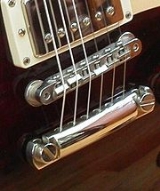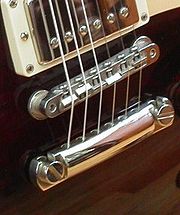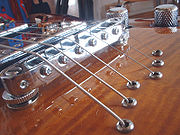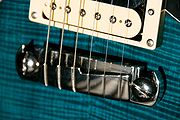
Stoptail bridge
Encyclopedia


Bridge (instrument)
A bridge is a device for supporting the strings on a stringed instrument and transmitting the vibration of those strings to some other structural component of the instrument in order to transfer the sound to the surrounding air.- Explanation :...
(sometimes also called a stopbar bridge) used on a solid body electric guitar
Electric guitar
An electric guitar is a guitar that uses the principle of direct electromagnetic induction to convert vibrations of its metal strings into electric audio signals. The signal generated by an electric guitar is too weak to drive a loudspeaker, so it is amplified before sending it to a loudspeaker...
or archtop guitar
Archtop guitar
An archtop guitar is a steel-stringed acoustic or semi-acoustic guitar with a full body and a distinctive arched top, whose sound is particularly popular with blues and jazz players.Typically, an archtop guitar has:* 6 strings...
is a specialized kind of fixed hard-tail
Hard-tail
The term hard-tail has several meanings:* A hard-tail guitar bridge for an electric guitar or archtop guitar is one without a tremolo arm or vibrato tailpiece....
bridge. Hard-tail bridged guitars are distinguished as a class from tailed bridge guitars by having no tremolo arm
Tremolo arm
A whammy bar, tremolo arm/bar, or vibrato arm/bar is a component of a guitar, used to add vibrato to the sound by changing the tension of the strings, typically at the bridge or tailpiece...
(also called a whammy bar ) or tremolo action.
Construction and materials
The stoptail bridge consists of two parts: an adjustable fixed bridge piece, such as a Tune-o-maticTune-o-matic
Tune-o-matic is a name of fixed bridge design for electric guitars. It was designed by Ted McCarty and introduced in the Gibson Les Paul Custom guitar in 1954. In 1955, it was used on the Gibson Les Paul Gold Top...
and a separate stopbar (or stop bar) tailpiece
Tailpiece
A tailpiece is a component on many stringed musical instruments that anchors one end of the strings, usually the end opposite the end with the tuning mechanism the scroll, headstock, peghead, etc.-Function and construction:...
.
A stopbar tailpiece is, as the name implies, a bar-shaped formed metal piece commonly made of pot metal
Pot metal
Pot metal, also known as monkey metal, white metal or die-cast zinc, is a slang term that refers to alloys that consist of inexpensive, low-melting point metals used to make fast, inexpensive castings....
or zinc
Zinc
Zinc , or spelter , is a metallic chemical element; it has the symbol Zn and atomic number 30. It is the first element in group 12 of the periodic table. Zinc is, in some respects, chemically similar to magnesium, because its ion is of similar size and its only common oxidation state is +2...
alloys although aluminum and brass
Brass
Brass is an alloy of copper and zinc; the proportions of zinc and copper can be varied to create a range of brasses with varying properties.In comparison, bronze is principally an alloy of copper and tin...
are sometimes found on more expensive models. Many manufacturers claim that the use of lightweight metals and alloys, such as aluminum, provide a greater transfer of the string's vibrational energy or "resonant quality" to the guitar body since there is less mass to excite. Aluminum was also used in the early examples of stoptail bridges from the 1950s, so it carries the mantle of "vintage" vibe.
The "stop" part comes from the fact that the string ends are held in place or they "stop" inside the bar. The bar is mounted on top of the guitar body usually by means of sturdy threaded metal studs screwed into threaded sleeves embedded into the body of the guitar. The studs and stopbar are located behind the separate bridge piece.
The stopbar can either simply slip onto notches on top of the studs, or be held in place using set screw
Set screw
A set screw is a type of screw generally used to secure an object within or against another object. The most common examples are securing a pulley or gear to a shaft. Set screws are most often headless , meaning that the screw is fully threaded and has no head projecting past the major diameter of...
s. One danger to be aware of is that the stopbar can fall out of the notches when changing strings and put a ding in the guitar's finish. When it is held in place using the screws, it is sometimes referred to as a "locking stopbar". In these designs, the Tune-o-matic bridge section is also usually fastened to its embedded studs by set screws. This fastening of the key components in a stoptail bridge system is claimed to impart more sustain and tone to the guitar's sound.
Function and advantages
The stopbar has holes drilled into it that allow the guitar strings to be threaded from the rear and out through the front. The string path then goes over the bridge saddles and the string nut to the machine headMachine head
A machine head is part of a string instrument ranging from guitars to double basses, a geared apparatus for applying tension and thereby tuning a string, usually located at the headstock. A headstock has several machine heads, one per string...
s located on the headstock
Headstock
Headstock or peghead is a part of guitar or similar stringed instrument. The main function of a headstock is holding the instrument's strings. Strings go from the bridge past the nut and are usually fixed on machine heads on headstock...
.
The stopbar tailpiece is meant to be adjusted for string tension. The threaded posts can be lowered or raised to increase or relieve the string tension at pitch. This is an important adjustment especially when changing the gauge of the string set on the guitar. There are practical limits to this technique: too high and you could bend the posts and the strings won't seat properly into the bridge saddles; too low and the string break will rest on the rear of the bridge, killing sustain and tone. Some players prefer to tighten the stopbar all the way down in an attempt to increase sustain and tone. This requires a different stringing technique.
Some players, like Duane Allman
Duane Allman
Howard Duane Allman was an American guitarist, session musician and the primary co-founder of the southern rock group The Allman Brothers Band...
, deviate from the norm and "top wrap" their strings. This is when the direction of the string path is reversed so that the strings are threaded through the leading edge of the stopbar then come out the rear and wrapped over the top of the stop bar. The advantage is that strings are supposedly easier to bend because of the decreased string break angle. Also, the "nonspeaking" string length is increased, which may have an effect on the strings' harmonic vibration (see sympathetic resonance
Sympathetic resonance
Sympathetic resonance is a harmonic phenomenon wherein a formerly passive string or vibratory body responds to external vibrations to which it has a harmonic likeness. The classic example is demonstrated with two similar tuning-forks of which one is mounted on a wooden box. If the other one is...
). The increased tendency for the strings to produce natural harmonics may make techniques such as pinch harmonic
Pinch harmonic
A pinch harmonic or pick harmonic is a guitar technique in which the player's thumb or index finger on the picking hand slightly catches the string after it is picked, canceling the fundamental of the string, and letting one of the overtones dominate. This results in a high pitched sound...
s easier to accomplish. This is the same way that a wraparound stoptail bridge is strung. Regardless of the technique used, the tension provided by tightening the strings to pitch is the only thing keeping the stopbar in place, unless it is a "locking" type.
The supposed advantages of using a stoptail bridge over a tremolo bridge are: greater ability to keep the strings in tune, especially under the duress of hard note-bending; better string path stability and ability to intonate; and, better sustain due to a more direct resonance of the guitar's tonewood
Tonewood
Tonewood generally refers to any wood which may be used in the construction of a musical instrument. Many acoustic properties are often assigned to specific wood species; however the description of these properties is itself a large subject and beyond the scope of this article...
excited by the transmission of sound wave energy from the vibrating string. This is not a universally accepted opinion and guitarists will argue over the virtues of stoptail, hard-tail and tremolo bridges probably for as long as they all exist.
The most often ascribed attributes of a stoptail bridge-equipped guitar are the "richer tone" and better sustain. The mysterious mojo surrounding the transference of resonance characteristics is a common theme when discussing the design and materials used in the construction of a stoptail bridge. These qualities are of course subjective and dependent upon many other factors of a guitar's construction and auxiliary equipment used in the sound chain.
Variations
Gibson Guitar CorporationGibson Guitar Corporation
The Gibson Guitar Corporation, formerly of Kalamazoo, Michigan and currently of Nashville, Tennessee, manufactures guitars and other instruments which sell under a variety of brand names...
guitars tend to be most often associated with the stoptail bridge, especially the iconic Gibson Les Paul
Gibson Les Paul
The Gibson Les Paul was the result of a design collaboration between Gibson Guitar Corporation and the late jazz guitarist and electronics inventor Les Paul. In 1950, with the introduction of the Fender Telecaster to the musical market, electric guitars became a public craze. In reaction, Gibson...
model, whereas Fender Musical Instruments Corporation guitars are most often thought of as tremolo bridges like the famous Stratocaster model.

Wraparound
A variant of a stoptail bridge is the "wraparound." Ironically, the wraparound is used both on the lowest end models of some makers like the Gibson Melody MakerGibson Melody Maker
In 2007, the Melody Maker became a separate model. It now has a smaller single-coil pickup than the P-90, a wraparound bridge/tailpiece unit, a mahogany neck, and a pickguard similar to the original Melody Maker...
which costs less than $400 and on the high-end boutique guitars like PRS Guitars
PRS Guitars
PRS Guitars is an American guitar manufacturer headquartered in Stevensville, Maryland. PRS Guitars was founded by guitarist and luthier Paul Reed Smith in 1985. The company is one of the leading manufacturers of high-end electric guitars.-Materials:...
which cost thousands. This design combines the bridge and stopbar into one unit. The wraparound can have movable bridge saddles, have a compensated system much like an acoustic guitar bridge or just be plain like a stopbar. The single piece unit is said to have a "sweeter" tone because it minimizes the points of contact with the string and thus more energy is transferred to the guitar body.

